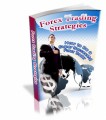Salespage Snapshot:

Table Of Contents
Foreword
Chapter 1: Introduction
Chapter 2: The Mindset And Trading
Chapter 3: How To Trade On The Forex
Chapter 4: Have Realistic Expectations
Chapter 5: Understand The Power Of Patience
Chapter 6: Be Organized In Your Approach To The Markets Chapter 7: Why Emotional Management is Critical to Trading Success
Chapter 8: Over Complicating Forex Trading Can Easily Induce Emotional Trading
Chapter 9: How Price Action Trading will Cure Emotional Trading Problems
Wrapping Up: The Winning Traits Of A Forex Trader
Sample Content Preview
Chapter 2: Markets The Forex Taps Into
Synopsis
Being the type of market that has the highest trading volume at any given time encourages the further participation of the various different countries. The high volume and liquidity makes the currency market a very attractive and viable platform for investment. The forex trading is also open to all such as traders, banking institutions, trading companies, financial and non financial institutions, companies and governments.
The Markets
One of the markets the forex often taps into is the tourists industry where the exchange of money is needed in order for the visiting tourists to make purchases and also cover all expenses during the stay at the foreign destination.
Therefore the exchange of currency would be processed via a currency broker and the said transaction would become part of the currency market. As this form of currency trading is not really suitable or viable for professional traders there are other forms of currency trading that are used for these types of transactions. And these would include currency futures markets and forex markets.
The forex markets exist for most of the major market currencies where the exchange of rates is between the two countries all of which is done in a twenty four circle, globally.
All of this is done directly as opposed to trading in contracts. Futures markets are currency futures provided by an exchange. This would mean that there is a centralized controlling system that keeps tabs on the pricing which is the same no matter where the trader is trading form globally.
In the past the forex has been used for negative reason of causing problems in other countries financials. This has brought quite a few economies to their lowest thus there are new legislations in place to prevent such conditions from reoccurring. There are also controls and “pegs” on currencies to curb such detrimental speculations.
Chapter 3: Exchange Rate Regime And Exchange Rate Flexibility
Synopsis
The flexible exchange rate system is where the exchange rate is decided and maintained on platforms that dictate the permanent fixed ration or the completely flexible ratio.
However this has different implication for the extent in which the relevant authorities are willing to participate in based on the foreign exchange market stability. The degree of flexibility dictates the category in which the transaction bodies determine which would include currency unions, dollarized regimens and currency boards.
The conventional currency pegs are also designed to be under fixed rates. The managed and independent “floats” are considered flexible regimens and are exposed to time inconsistency problems and exchange rates that are rather volatile even at best in different degrees.
The Rates
The exchange rate regime is basically how a country manages their currency issues in connection to that of other currencies and the foreign exchange market. The monetary policy designed and adopted is generally dependant on the factors that are also dictated to by the monetary policy in place. Actively playing a part in keeping the rates fairly stable by having a pegged float, the central bank is able to keep the rates from deviating too much, either high or low.
Over time some countries have opted to shift away from the fixed rate regime and move towards a more flexible rate which is mainly based on the supply and demand of the said currency. However too much volatility in the global markets can cause challenges for countries adopting this over time, as shown in the globalization platform that can amplify the costs of incorporating inappropriate policies which results in trading looses.
Most governing bodies are not trying to determine which policy works best and is to their advantage in relation to the global sentiments. Many are considering the decision to make the transition from fixed to floating currencies.
Chapter 4: Fixed Exchange Rate Measured Against Floating Exchange Rate
Synopsis
Making the right choice between the two options will dramatically dictate the survival of the currency stability and the trading platforms tagged to the movements caused by the said currencies. Therefore most governing powers are constantly exploring the suitability of the adoption of either of these two fairly opposing styles of currency rates.
Fixed and Floating
The smaller and more open the particular country’s economy, the more apparent choice would be that of the fixed exchange rate.
This is mainly dictated to by the fact that a lot of the stability issues for trading are connected in some way to the dependency on exports and imports.
Here the best regime choice would be based on the ideally stabilizers for the macroeconomic performance that will help to minimize the fluctuation on output, consumption and domestic pricing levels or other variables. However in most countries the usage of both styles is incorporated in varying degrees of flexibility.
The usage of the fixed exchange rate would be preferable if the country’s economy is faced with challenges that are mostly monetarily connected.
The flexible rate is preferable if the fluctuations apparent condition is volatile and is usually caused by other issues such as changes in the demands for the domestic goods, exports and imports.
There are some quarters that are of the opinion that having a fixed regime where the adoption of the pegged exchange rate is in place would ensure the inflation rates are kept low or at the very least controllable.
However this is not a complete ideal situation to be in, particularly if there is a need to increase borrowing as the interest rates can pressure the exchange rate pegged due to the fixed regime.
A floating rate however provider room to maneuver around a lot of these problems. However it also contributes in some ways to the rise in inflation but for the governing body this constitutes the possibility of increasing the tax revenues.
Other Details- 1 Article (DOC)
- 1 Ebook (DOCX, PDF), 21 Pages
- 1 Lead Magnet Report (DOC, PDF), 11 Pages
- 1 Autoresponder Email Messages (TXT)
- 1 Salespage (HTML)
- Ecover (JPG)
- File Size: 27,007 KB












